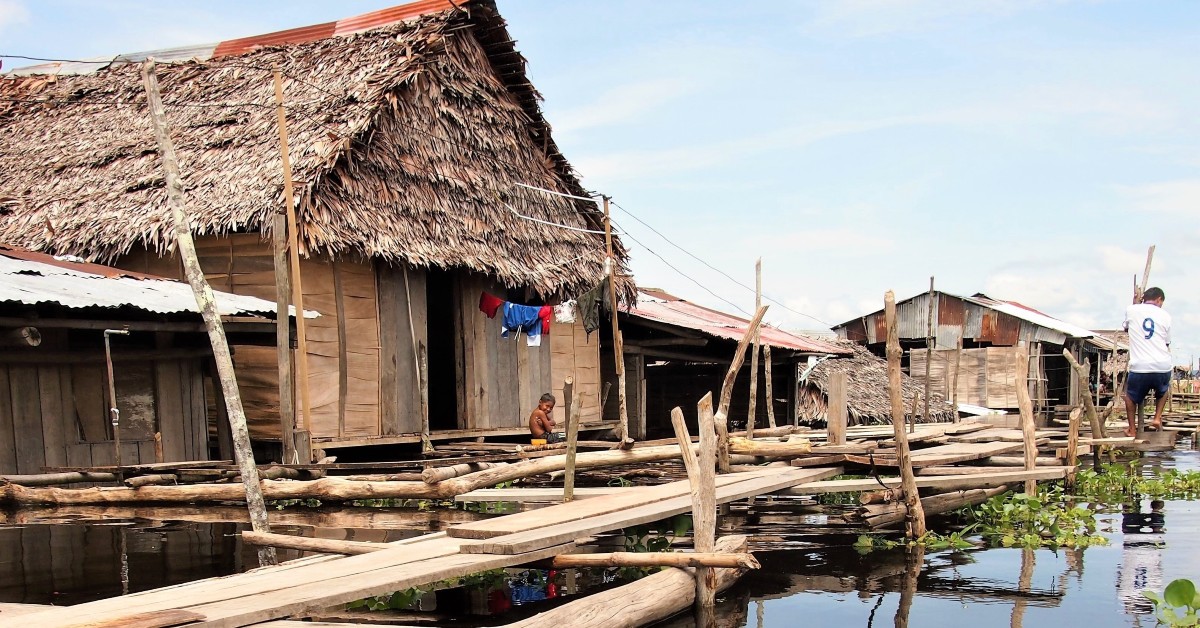Loreto, an idealized destination for many nature-loving tourists, projects a reality that contrasts fiercely with the green mantles of the Amazon. This Peruvian jungle department exposes a difficult environmental challenge, especially because current legislation does not facilitate the task. In 2018, reported Gestión, Peru ranked 22nd in World Air Quality’s report on countries with the highest environmental pollution. Loreto is Peru’s largest department, yet it also has some of the poorest waste management nationwide. What fait awaits it?
On pollution in the Amazon
There is a crisis in the coverage of basic services in the Peruvian department of Loreto. This region has a large rural population, which tends to live on or near the banks of the various bodies of water in the territory or in floating houses.
According to the Regional Report of Social Indicators of the Department of Loreto, last modified in 2021, its percentages of access to basic services are below the national level.

Only 44.3% of Loreto’s population has access to basic water, electricity, and sanitation services.
On the other hand, as confirmed by the Central Reserve Bank in a 2019 summary of the main economic activities in Loreto, fishing dominates the region’s development. Due to the population’s dependence on rivers, they should be conserved. However, the Nanay, Amazon, and Itaya rivers, as well as the Rumococha Lagoon and Lake Moronacocha, are all used as wastewater reservoirs in Iquitos (a popular tourist city in the department of Loreto).
When visiting the ports of the city of Iquitos and the human settlements in flood zones, the magnitude of the Amazon’s pollution can be seen on the riverbanks. Full of plastic waste, fecal matter, toxic liquids, and other contaminants, many inhabitants live under inhumane conditions, in areas that have become uninhabitable. It is their home, their source of income, yet also a source of disease. But current legislation prevents the State from providing these areas with sanitation services.
Contradiction in Peruvian legislation
While the pollution in Loreto is due to local economic development without considering its effect on nature, the State has the responsibility to make sustainable development viable in the Amazon. Article 195 of the Peruvian Constitution specifies that, as sovereign over the national territory, it is the State’s responsibility to develop the territory.
Contradictorily, Peruvian law contains an article approved by the Constitutional Court that hinders the State’s ability to guarantee the quality of life of the population. Law 30645 makes it impossible to install drinking water, sewage, etc., in flood zones.
Morally and economically, there are justifications for this law. It is dangerous to install housing in the areas considered high risk that cannot be mitigated. For this reason, it would be irresponsible to try to develop these areas when inhabitants would constantly face risks of natural disasters such as landslides or floods.
On the other hand, this law has an article that protects the occupants of these highly unstable areas, which also contributes to the economic protection of the State. The occupants of these areas can benefit from a relocation program, which the same law confirms is more viable in budgetary terms than constantly conditioning the danger zones. But most citizens refuse to relocate because it takes them away from the central business areas.
Acquisition and occupation of risk zones are prohibited, and the state also prohibits providing sanitation services in such areas, according to Gestión. However, due to population expansion and the fact that 32% of the region is wetland, it is impossible for citizens not to settle in risk zones over time.
In addition, climate change has left Loreto even more vulnerable. In Iquitos alone, its main city, 20% of the territory is flood-prone, and the projection indicates that this percentage will increase. In 1996, Loreto recorded 188 days of rain and 46 storms. In 2016, it recorded 219 days of rain and 66 storms. Thus, Law 30645, although in force, is not adapted to the reality experienced by the Loreto region.
Final reflections
State intervention could help reduce pollution in Loreto. The rivers are used as waste disposal sites because most of the inhabitants do not have alternatives to facilitate waste disposal. Is this possible, despite legislation that currently prevents providing services in flood zones? As background, the Constitutional Court has previously made constitutional rights prevail over other laws. Therefore, it could also apply in this case.
However, if a thorough analysis determines it is impossible to provide sanitation services, the housing relocation project should be implemented. Relocation projects such as Nuevo Belen and the state awareness campaigns that have been carried out to date have not been well received because the opinion of the inhabitants of the human settlements was not considered. The success of these future projects depends on cooperation between the State and the population.
Main image by Deb Dowd via Unsplash
About the Author
Melyssa Revilla Romano is a Peruvian copywriter who has worked with advertising agencies and currently works as a freelance content creator. She holds a degree in Communication Sciences from the Universidad Peruana de Ciencias Aplicadas (UPC).

